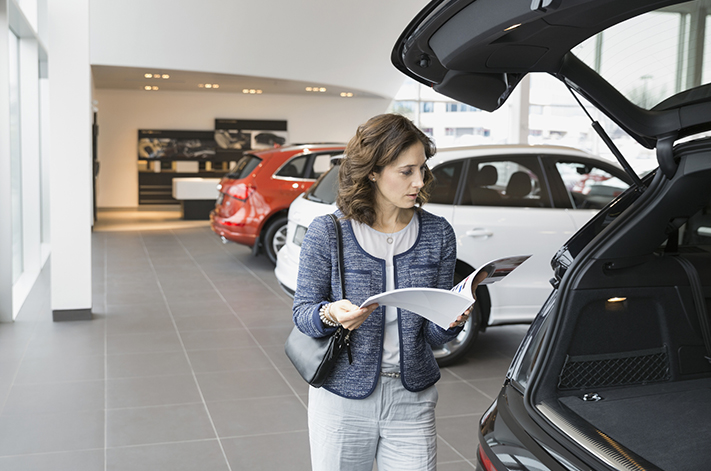
An hour is good, a day is better, but in the end, six months is best.
Twenty minutes of test-driving a car, which is what you’ll get at most car dealers (at the high end, if you’re pushy, you might get to take one overnight), really isn’t enough to make such an important decision.

Sure, getting someone to lend you a car for half a year isn’t going to be easy, unless you work for a car magazine or website.
Drive a car for a day and it may well impress you but live with it for a few months and any faults, flaws or bug-bears will gradually become clear.
There’s also the chance to test real-world, day-to-day family friendliness, seat comfort and actual (as opposed to ‘claimed’) fuel economy.
Most new car reviews are written off the back of a launch drive that will last anywhere from one hour to five or six behind the wheel, and in many cases that’s more than enough to form a solid, professional opinion about a car.

What you, as a buyer, are more likely to be faced with is the challenge of assessing and deciding on the comfort, amenity and possibly intangible joy levels of a car in just 20 minutes.
What chance have you got? Well, if you consider that we all think we can decide whether a movie is worth seeing off the back of a 90 second trailer, you’d have to back yourself at least a bit.

BEFORE THE CLOCK STARTS TICKING
There’s actually quite a lot you can learn in the dealership, before you even ask the salesman for a drive.
Two of the most important features of a car are comfort and visibility and you can form a fairly robust opinion whether you’re going to like the seats just by sitting in them for five minutes or so. While you’re there, take the time to familiarise yourself with the quality of the materials, whether you like the touch and feel and whether it seems in line with the price you’re paying. If not, maybe there’s some options you can select to make the experience more palatable.
You’re going to spend a lot of time sitting here, so you want it to be comfortable and ensure the seats are supportive.
Check the support under your thighs and around your lower back in particular. Seats that are too soft are no good, but neither are seats that are too firm. It’s the Goldilocks standard you’re after.
You should also note the amount of shoulder and head room, particularly if your partner is larger than you and for the kids, get in the back and check the amount of knee room and the comfort of the rear bench. Under-thigh support is often an issue in the rear and one that can see complaints flying from the second row in due course.
Also get a feel for the controls, buttons and knobs and whether they come to hand easily and logically. Play with the in-car entertainment and other features. Sat-nav systems, in particular, can be infuriating in some cases.
The dealership is also a good place to check the size of the boot or load area, and whether there’s a full size spare, space saver or bottle of goo.
If you regularly carry something big in your car (like a child) bring it/him/her with you and have a go at getting it in and out. Hip heights and the shape of the loading space can be very different between cars and the convenience will make a big difference day to day.
If a car dealerships get iffy with your testing regime, take your business elsewhere. At the end of the day, you’re the one with the power so make sure you comfortably test the car in a way that it would normally be used.
Additionally, be confident in asking not to be bothered while having a proper look at the car. Having a sales assistant come up to you asking questions can take your mind off the task at hand, so make sure you get ample alone time.

LOOKING GOOD
Visibility is hugely important in a car and being able to see well can make the difference between having an accident and avoiding one. Check your blind spots, both in the dealership and when you go for your drive, and evaluate whether the A-pillars (the bit of metal that connects the bonnet to the roof, right in front of you) are so thick that they can obscure cyclists or pedestrians. Having to look around them constantly at intersections will be painful.
A sense of a car’s visibility is something that you instantly get, some cars feel light and airy and easy to see out of, while others – particularly convertibles when the roof is up – feel like driving with a letterbox on your head.
ON THE ROAD
This is the hard part, because you’re trying to take in a lot of information in a short time, although some things are instantly obvious.
Do you like the steering? Is it too heavy or too light, is it too talkative or too dead at the straight-ahead? This is a real personal preference thing, and if you’re buying a sports car rather than a family car it will be more important.
Quick tip, always ensure the vehicle you’re test driving has insurance and valid registration.
It’s unlikely you’ll get on to a highway to see what it’s like at 110km/h, but if you do be sure to note the amount of road noise and engine noise and how hard the engine has to work to overtake.
Be sure you do find a steep hill to drive up and check how much the car has to chug in that first third, and how much straining you hear from under the bonnet. Similarly, from a standing start, make sure you’re happy with the acceleration and the smoothness of gear shifts.

Also insist on doing a three-point turn to check the turning circle and a reverse park to see how difficult it is.
If you get to throw the vehicle at a corner, try to assess the grip levels and whether there’s any tyre slip or squeal. Be sensible here.
Give the brakes a good stomp as well, not just to see the look on the face of the dealer sitting next to you, but to see if the feel and stopping power are good, and how heavily the ABS shudder kicks in.
ASK YOURSELF THIS
In the end, the decision to buy one car over another is about more than just the sum of all these little things. Some cars just feel more right than others, they suit your style, the way you drive, how you sit, what you like to look at.
Sometimes the interior quality is so special or so nice to look at, that you’ll want to buy a car, because you know that being in it will make you happy every day. In others, it’s the way it steers and handles and holds through corners that will convince you.
These things, fortunately, can be assessed in a 20-minute test drive, but if you’re not sure of the other details, go back and demand another go and be sure to drive all the competitors as well, repeatedly if necessary.
Buying a car is a big decision and you’ll have plenty of time to rue it if you get it wrong. Twenty minutes isn’t a lot of time to get it right.



